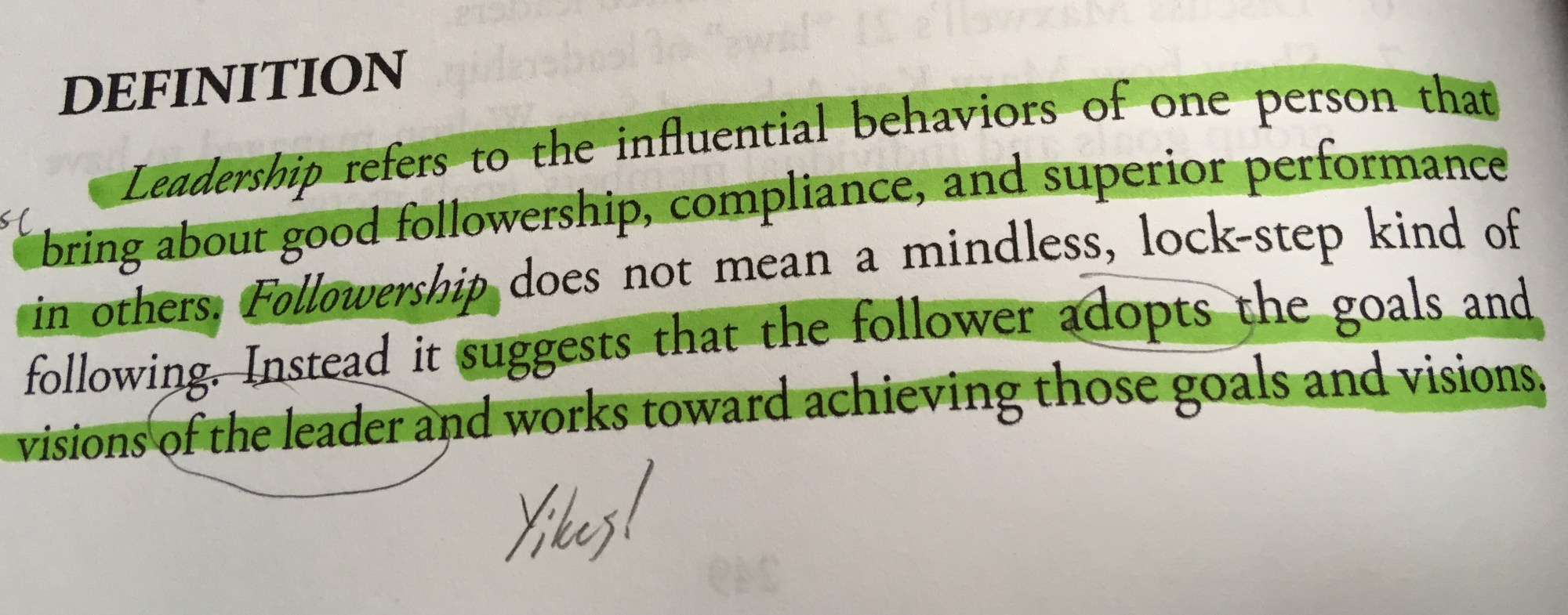As a mathematician, I know that definitions are important. Precision and clarity about what we’re talking about can mean the difference between truth/reality and error/misconception.
But as a follower, as a leader, as someone committed to personal development, I see that it’s possible that we might get so bogged down in definitions that we never actually get to the point of wrestling with the real issues and engaging in real growth, transformation, and change.
With the many varying definitions of leadership, it would be possible to spend a lifetime just debating what leadership is, rather than ever truly moving forward in leading with excellence.
As a topic of inquiry, followership is new enough that it seems to me that things have not yet already become so convoluted and disparate in their presentations and definitions—although there’s certainly the possibility that we will end up that way soon enough.
 A few weeks ago, I mentioned that when I drafted my first manuscript of Embracing Followership: How to Thrive in a Leader-Centric Culture I didn’t want to provide any definition of followership at all; I simply wanted to move into exploring the ideas and realities behind contributing with excellence.
A few weeks ago, I mentioned that when I drafted my first manuscript of Embracing Followership: How to Thrive in a Leader-Centric Culture I didn’t want to provide any definition of followership at all; I simply wanted to move into exploring the ideas and realities behind contributing with excellence.
So why spend time even considering definitions (as I’ve done several times in previous posts)? For me, proposed definitions of leadership and followership can provide helpful platforms for reflection and discussion, which can launch us from fresh thinking into excellent action.
Here’s one uncommon definition of leadership, which contains some significant references to followership:
 “Leadership refers to the influential behaviors of one person that bring about good followership, compliance, and superior performance in others. Followership… suggests that the follower adopts the goals and visions of the leader and works toward achieving those goals and visions. To be a leader requires that followers comply with the leader’s directives at some level…. Leaders, if they are leaders, bring out superior performances in their followers.”
“Leadership refers to the influential behaviors of one person that bring about good followership, compliance, and superior performance in others. Followership… suggests that the follower adopts the goals and visions of the leader and works toward achieving those goals and visions. To be a leader requires that followers comply with the leader’s directives at some level…. Leaders, if they are leaders, bring out superior performances in their followers.”
–from Forming Storming Norming Performing: Successful Communication in Groups and Teams, by Egolf & Chester; p. 250f
What do you think? What reactions or questions does this definition raise? Then, what actions and contributions does it prompt?
Here are a few points that stand out to me:
- While many authors will equate leadership with influence, I appreciate that this definition targets that influence on the facilitation of followership and excellent contribution. While goals and vision are also mentioned, the primary thrust of a leader’s leadership is the quality of the followers’ engagement. This definition is bracketed by the ideas of “good followership” and “superior performances” in followers. For me, leadership exists primarily to encourage this kind of excellence. This is the heart of servant leadership as I understand it.
- There are some strong words here: bringing about “compliance” (mentioned twice) and adopting the leader’s goals and visions. Compliance is a weighty word, but I think there is a strong responsibility of followers toward the traits and actions of obedience, submission, honor, humility, and decision-taking. If followership is indeed a significant role, there should be significant expectations on followers. This is what separates our kind of followership from social media followers: there are no expectations of any sort when one becomes a Twitter fan.

- “Adopting the leader’s goals and visions” makes me say, “Yikes!” Initially, this sounds like a follower gives up his or her own plans and takes on someone else’s. But that’s not what’s being said. The un-highlighted line above clarifies that followers aren’t mindless automatons simply taking instructions and following orders to fulfill others’ plans. Rather, the notion of adoption is a profound one. Adopting a child is a beautiful, significant, powerful act of relationship, which manifests a deeply held desire to be a parent to a child in need. Similarly, adopting the goals and vision of someone else, of a leader, a peer, a group or organization, can be—should be—the outworking of expressing one’s own passions and concerns, the choice to enter into a relationship in order to bring about the fulfillment of something you care about. This is the foundational concept of ‘ownership’ (see Chapter 7).
- There is an interesting metric here. The final line in the quotation says, “Leaders, if they are leaders, bring out superior performances in their followers.” Want to know if you’re leading well? Consider the quality of your followers’ contributions. (And make use of our free downloadable leadership self-evaluation.) Are they able to exhibit excellence, as in, are you as a leader creating an environment, providing access to resources and networks, which make it possible for your followers to do their best work in fulfillment of the group’s common goals?
Do I wholly accept the definition of leadership (or the implications for followership) exhibited here? No, but the exercise of reflecting on the definition is an important facet of our development, shaping our thinking, building our paradigm of followership, and prompting us to action.
What are my takeaways from reading this particular definition? For me, fully embracing that sense of ownership, adopting the goals of others as a manifestation of my own interests and aims, is something that I want to engage more deeply.
And, the ongoing challenge of considering myself in my leadership: are my followers able to provide “superior performances,” in part as a result of my encouragement and facilitation? Perhaps I’ll ask them, at next week’s area-wide meeting!
What are your reflections and takeaways from this leadership-followership definition?
~~~
For encouragement and guidance in understanding and applying yourself to following and leading with excellence and helping others to do the same, see:
 Embracing Followership: How to Thrive in a Leader-Centric Culture (by Allen Hamlin Jr; Feb 2016), and A Discussion Guide for Teams & Small Groups (Dec 2017).
Embracing Followership: How to Thrive in a Leader-Centric Culture (by Allen Hamlin Jr; Feb 2016), and A Discussion Guide for Teams & Small Groups (Dec 2017).
Along with our variety of free downloadable resources and the index of other posts on this site.
